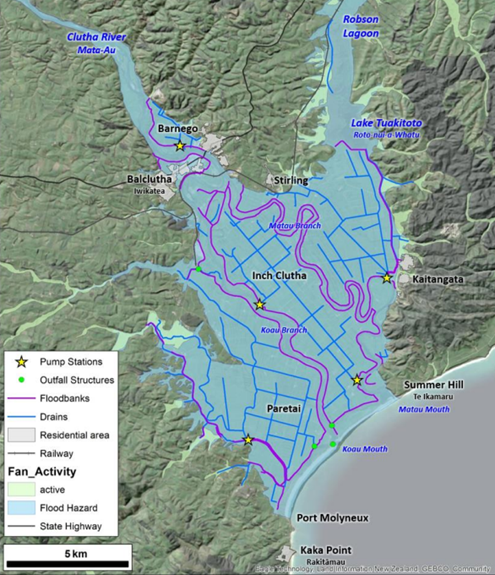ORC’s Manager Natural Hazards Jean-Luc Payan says the delta’s natural hazards issues are challenging to manage due to the complex inter-relationships between the natural hazards and environmental processes, land use and infrastructure.
He says a natural hazard risk assessment will be required following completion of new natural hazards investigations, which would include detailed assessments of the main natural hazard risks in the delta area, consideration of the changing future risk profile, and of residual risks for the flood scheme areas.
“Although there’s uncertainty in the rates of change, climate change, sea level rise and shoreline retreat are expected to have inevitable and increasing impacts on the lower delta area,” he says.
The report Clutha Delta Natural Hazards Adaptation was prepared for today’s meeting of the ORC’s Safety and Resilience Committee, which noted the report, and includes plans for a coastal hazards study, flood and liquefaction hazard assessments, evaluations of the ORC’s flood protection and drainage scheme, and community engagement.
The low-lying Clutha Delta, around the mouth of the Clutha Mata-Au River, have a complex natural hazard setting, being exposed to a range of coastal, river and seismic natural hazards, which can also be expected to be exacerbated by potential impacts of ongoing or projected geological and climatic changes.
“Adaptation decision-making may be required in relatively short timeframes, for example in the Koau mouth area where coastal erosion is already having an impact on the performance of the river mouth and ORC’s drainage infrastructure,” Dr Payan says.
Dr Payan says the natural hazard management approach used for the Clutha Delta is the same being applied to ORC’s other natural hazard adaptation programmes; the South Dunedin Future programme, and also the Head of Lake Whakatipu Natural Hazards Adaptation programme around Glenorchy.
The method is known as Dynamic Adaptative Pathways Planning, developed by the Ministry for the Environment as a blueprint for community-influenced decision making in areas affected by natural events and climate change.

ORC flood protection and drainage scheme infrastructure in the Clutha Delta area - flood banks, drains and pump stations.
Earlier hazard reports for ORC have noted erosion in some coastal Clutha Delta areas of between 4-9 metres a year.
Plans for developing flood hazard mapping
Dr Payan says a comprehensive hydraulic modelling study and flood hazard assessment is planned to further develop ORC’s flood hazard mapping and understanding, to inform evaluation the flood protection scheme performance, and as a to guide Emergency Management planning for flooding events.
This will be first update of flood hazard assessments for the Clutha Delta since 2005, he says.
Flood hazard assessment is expected to include the impacts of climate change and sea level rise, flood bank breach scenarios, and potential extreme flooding scenarios, such as bank overtopping.
A liquefaction hazard assessment is also planned to understand in more detail the hazard and potential impacts of liquefaction in the area.
Dr Payan says the next steps are to discuss with programme partners; Clutha District Council, mana whenua and Emergency Management Otago, the proposed work programme and identify opportunities for participation in programme governance, management, and delivery.
He highlighted the objectives of an engagement plan will be to identify and connect with partners, affected communities and stakeholders, to consider community values, views, knowledge and objectives.
The Lower Clutha Flood Protection and Drainage Scheme on the Clutha Delta
ORC owns and manages the Lower Clutha Flood Protection and Drainage Scheme on the Clutha Delta, which is 110.9 kilometres of flood banks and structures, which protect the townships of Balclutha, Kaitangata, adjacent rural areas and the delta.

Clutha Mata-Au River floodbank at Balclutha township
Dr Payan says flooding is the most recognised and frequent natural hazard on the delta; citing three floods of between 4160-5600 cubic metres per second (cumecs), in 1878, 1978 and 1999.
“In the November 1999 flood event the Clutha Mata-Au River remained at more than 3000 cumecs for about 60 hours. If there was a structural failure of the flood banks, the flooding consequences are potentially very severe,” he says.
The Clutha Delta natural hazards programme is included in the Council’s 2021-2031 Long-Term Plan and the 2023-2024 Annual Plan as a key Natural Hazards work activity. The Annual Plan specifies the project as Planning and strategy development for managing natural hazards risk for Clutha Delta.
The Clutha Delta report is available for download: item 9.3 on Agenda
https://www.orc.govt.nz/media/15475/2023-11-09-sr-committee.pdf
Earlier, 2021 ORC reports on Clutha Delta erosion and sea-level rise
